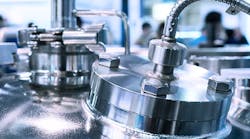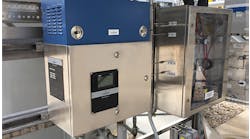This Month’s Puzzler
We installed a new automatic sampler in our catalyst bed reactor (see figure). It replaced an old corroded manual station that was fouling. The manual station worked but some of our new operators warned it posed a burn risk; veteran operators had developed a knack for avoiding that risk. So, the safety department mandated putting in an automatic sampler.
The sampler manufacturer insisted on the installation of a Y-strainer but the pipe layout didn’t have space for one. Our project engineer downplayed the need because the sampler had a built-in strainer; he had a drain valve installed to blow nitrogen into the strainer to clean it.
I checked the boneyard and the old station had a Y-strainer but, on closer examination, the screen was corroded with extra holes in it. I noted that someone had welded a finer mesh into the strainer.
The constructor installed the ball valve at the inlet but the vendor insisted on a needle valve.
Quality control is complaining that the sampler results are erratic.
Operations doesn’t like the blowdown procedure, saying it’s unsafe and messy; an operator already has been hurt when his safety glasses were blown off his face. We’re blowing down the sampler twice a shift. Blowing down doesn’t help as much as expected; operators still have to rod out the inlet piping.
What can I do to improve operation of the automatic sampler? How can we improve safety? What do you think?
Check Various Factors
Consider the following points:
1. As the problem statement indicates, plugging and corrosion are among the key issues with this system. Typically, particulate content of the process (and, hence, sample) and its viscosity will prompt plugging problems. Catalyst attrition, corrosion and erosion are some of the factors that will cause plugging. Because the sample inlet piping is plugging frequently, straining or filtering the sample close to the reactor (at the sample tap at the reactor) will help minimize clogging of the inlet piping to the sampler. Particulate distribution will govern the mesh size of the strainer screen or that (pore size) for filters.
2. Although an inlet strainer or a filter are desirable, you have severe space limitations. So, consider an alternative location, including outlet piping, that does not have a space constraint and still can get a representative sample. If you opt for outlet piping, install the sample tap on the top or side of the pipe. Avoid bottom entry. In addition, if the outlet pipe is large, say, 3 in. or more, ensure the sample tap is not flush with the pipe but extends into it. Spare nozzles on the reactor could also be potential spots for the sample tap.
3. If viscosity is a contributing factor to plugging, you must consider keeping the piping and the sampler at proper temperature.
4. The issue of erratic sample results, as pointed out by Quality Control, could have numerous causal factors including, for example, the sampler and sample system, automatic sampler controls (timing, sizing of individual samples as part of the composite sample), flow pattern in the reactor, and analyzer issues. First, focus on the issues you can resolve quickly (such as plugging of the sample inlet) and then, if the problem (of erratic results) persists, look deeper into other factors.
5. Because the auto-sampler is relatively new, it is not possible to say if the corrosion issue is solved. Check that piping and tubing materials (e.g., Type 316 stainless steel) and seals are adequate for long-term corrosion-free service.
6. Although relatively unlikely, if, after implementing all corrective steps discussed above, the problem of erratic sample results continues, there may be a bigger issue — the flow distribution in the reactor itself. Obviously, this will directly and adversely affect your product quality. You may need to open the reactor for inspection/repairs.
7. Manual rodding frequency should be minimized; with proper inlet filtration and corrosion control, its frequency will go down. Consider adding proper isolation valves so an operator can do rod-out safely, and requiring personal protective equipment, e.g., face shield and appropriate skin and respiratory protection. Have the operators, operating engineers and safety folks review the revisions.
GC Shah, consultant
Houston
Investigate The Background
Blowing down, as it’s being done today, isn’t working. Keeping the sampler clean is bringing your operators closer to, instead of further from, the dangers of the process. Talk to the project engineer or whoever suggested blowing down to find out why the person thought it would work.
In addition, the quality of the sampling has degraded. The question you must ask is: Is there a way to clean the sample after it’s taken that won’t degrade the sample.
Here’s another thought. If straining was necessary, does the sample truly represent the product in the bed? Investigate this issue to decide if sampling here really is productive.
A ball valve won’t provide good isolation so operators safely can clean the inlet of the sampler by hand. Therefore, perhaps the first move is to replace the ball valve with a twin-seated plug valve or a spectacle blind if space is limited. A twin-seated plug valve has a narrow width and can ensure tight shut-off; however, the internal relieving port drain, between the seats, must be carefully designed to prevent fouling.
Also, ask the sampler supplier why it specifies a needle valve. You likely will gain some insight into the vendor’s past experience. In addition, change the piping to enable its disassembly as needed.
Because fouling has been a long-term problem with samplers, perhaps you can use this opportunity to identify the material causing the fouling. Catalysts tend to degrade and even become finer; this investigation might spur a look for a longer-lasting catalyst.
As a last resort, consider replacing the sampler altogether. Find out the supplier’s competitors and start the bidding again. Let the current vendor know and give it a chance to fix the problem before you go elsewhere — a little incentive is helpful.
Dirk Willard, consultant
Wooster, Ohio
August’s Puzzler
We’re finally fixing some of the steam problems that have plagued our plant. The boiler failed and we’re replacing it.
Of course, our first challenge was obsolete drawings. Our boiler room and many plant pipe racks are a rat’s nest of active and abandoned pipe. Corporate is funding the boiler replacement project and has hired a firm to complete a fresh set of piping and instrumentation diagrams, rack drawings and isometrics. That firm is finding a lot of overloaded racks as well as thermal expansion issues that someone thought were easily solved with expansion joints that now leak unexpectedly.
And then the fight began. Corporate wants all the condensate returned to avoid an expansion of the make-up water. I hate this idea because half our users operate below 1,500-lb/h steam. A survey shows that 20% of the users consume 300 lb/h or less. Corporate also would like to reduce our blowdowns for the cooling tower and boiler although the city isn’t pressing us about our water use and the area hasn’t suffered a drought in 20 years.
Then, there is the tendency to oversize our steam traps. I see 1-in. traps where the control valve is 1-in. or smaller.
Lastly, I would like the boiler replacement project to include a review of our boiler feedwater treatment. We use Type 316 stainless steel but still see rapid corrosion of our pipe; typically, pipe lasts only 8–12 years before it rusts away from the inside out. We use river water from the city.
We’re concerned that available funding won’t allow us to address all the problems. What is the best approach to make the most of the expansion?
Send us your comments, suggestions or solutions for this question by July 16, 2021. We’ll include as many of them as possible in the August 2021 issue and all on ChemicalProcessing.com. Send visuals — a sketch is fine. E-mail us at [email protected] or mail to Process Puzzler, Chemical Processing, 1501 E. Woodfield Rd., Suite 400N, Schaumburg, IL 60173. Fax: (630) 467-1120. Please include your name, title, location and company affiliation in the response.
And, of course, if you have a process problem you’d like to pose to our readers, send it along and we’ll be pleased to consider it for publication.

